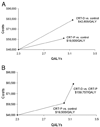Interpreting the results of cost-effectiveness studies
- PMID: 19095128
- PMCID: PMC2716087
- DOI: 10.1016/j.jacc.2008.09.018
Interpreting the results of cost-effectiveness studies
Abstract
In developed nations, health care spending is an increasingly important economic and political issue. The discipline of cost-effectiveness (CE) analysis has developed over several decades as a tool for objectively assessing the value of new medical strategies, by simultaneously examining incremental health benefits in light of incremental costs. The underlying goal of CE research is to allow clinicians and policymakers to make more rational decisions regarding clinical care and resource allocation. This review will provide the reader with an understanding of the theoretical underpinnings of CE analysis, the types of analyses commonly performed and reported in the medical literature, some important strengths and weaknesses of different analytical approaches, and key principles in the interpretation of CE results. Key principles reviewed include the impact of analytic perspective, the importance of proper incremental comparisons, the effect of time horizon, and methods for exploring and describing uncertainty. Illustrative examples from the cardiology literature are discussed.
Figures





Similar articles
-
Generalisability in economic evaluation studies in healthcare: a review and case studies.Health Technol Assess. 2004 Dec;8(49):iii-iv, 1-192. doi: 10.3310/hta8490. Health Technol Assess. 2004. PMID: 15544708 Review.
-
How to develop cost-conscious guidelines.Health Technol Assess. 2001;5(16):1-69. doi: 10.3310/hta5160. Health Technol Assess. 2001. PMID: 11427188 Review.
-
The future of Cochrane Neonatal.Early Hum Dev. 2020 Nov;150:105191. doi: 10.1016/j.earlhumdev.2020.105191. Epub 2020 Sep 12. Early Hum Dev. 2020. PMID: 33036834
-
Economic foundations of cost-effectiveness analysis.J Health Econ. 1997 Feb;16(1):1-31. doi: 10.1016/s0167-6296(96)00506-1. J Health Econ. 1997. PMID: 10167341
-
Folic acid supplementation and malaria susceptibility and severity among people taking antifolate antimalarial drugs in endemic areas.Cochrane Database Syst Rev. 2022 Feb 1;2(2022):CD014217. doi: 10.1002/14651858.CD014217. Cochrane Database Syst Rev. 2022. PMID: 36321557 Free PMC article.
Cited by
-
Methadone, Buprenorphine, or Detoxification for Management of Perinatal Opioid Use Disorder: A Cost-Effectiveness Analysis.Obstet Gynecol. 2019 Nov;134(5):921-931. doi: 10.1097/AOG.0000000000003503. Obstet Gynecol. 2019. PMID: 31599845 Free PMC article.
-
Equitable access to cell and gene therapies in South Africa: opportunities and hurdles.Gene Ther. 2023 Feb;30(1-2):180-186. doi: 10.1038/s41434-021-00309-y. Epub 2022 Jan 8. Gene Ther. 2023. PMID: 34997201 Review. No abstract available.
-
Systematic review on cost-effectiveness analysis of school-based oral health promotion program.PLoS One. 2023 Apr 20;18(4):e0284518. doi: 10.1371/journal.pone.0284518. eCollection 2023. PLoS One. 2023. PMID: 37079535 Free PMC article.
-
P2Y12 inhibitors in neuroendovascular surgery: An opportunity for precision medicine.Interv Neuroradiol. 2021 Oct;27(5):682-694. doi: 10.1177/1591019921991394. Epub 2021 Feb 4. Interv Neuroradiol. 2021. PMID: 33541183 Free PMC article.
-
Cost-effectiveness of adding measurement of Chlamydia trachomatis infection and serology to trachoma prevalence surveys in Tanzania and Mozambique.PLoS Negl Trop Dis. 2025 Jul 21;19(7):e0013257. doi: 10.1371/journal.pntd.0013257. eCollection 2025 Jul. PLoS Negl Trop Dis. 2025. PMID: 40690534 Free PMC article.
References
-
- Mongan JJ, Ferris TG, Lee TH. Options for slowing the growth of health care costs. N Engl J Med. 2008;358:1509–1514. - PubMed
-
- Bodenheimer T. High and rising health care costs. Part 2: technologic innovation. Ann Intern Med. 2005;142:932–937. - PubMed
-
- Cutler DM, Rosen AB, Vijan S. The value of medical spending in the United States, 1960–2000. N Engl J Med. 2006;355:920–927. - PubMed
-
- Mark DB. Visualizing cost-effectiveness analysis. JAMA. 2002;287:2428–2429. - PubMed
Publication types
MeSH terms
Grants and funding
LinkOut - more resources
Full Text Sources

